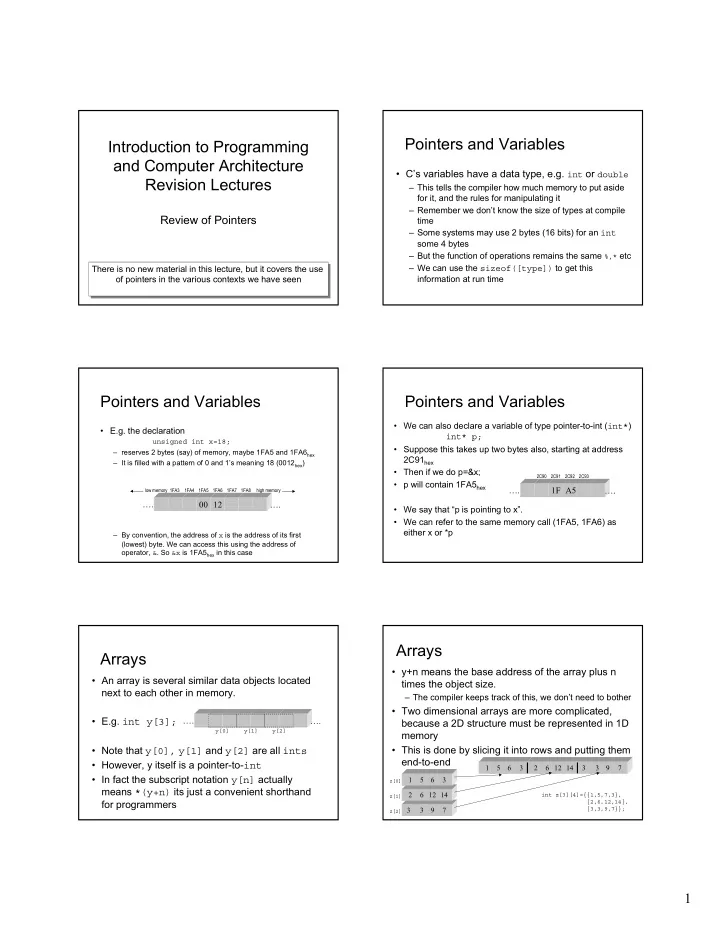

Pointers and Variables Introduction to Programming and Computer Architecture • C’s variables have a data type, e.g. int or double Revision Lectures – This tells the compiler how much memory to put aside for it, and the rules for manipulating it – Remember we don’t know the size of types at compile Review of Pointers time – Some systems may use 2 bytes (16 bits) for an int some 4 bytes – But the function of operations remains the same %,* etc – We can use the sizeof([type]) to get this There is no new material in this lecture, but it covers the use There is no new material in this lecture, but it covers the use information at run time of pointers in the various contexts we have seen of pointers in the various contexts we have seen Pointers and Variables Pointers and Variables • We can also declare a variable of type pointer-to-int ( int* ) • E.g. the declaration int* p; unsigned int x=18; • Suppose this takes up two bytes also, starting at address – reserves 2 bytes (say) of memory, maybe 1FA5 and 1FA6 hex 2C91 hex – It is filled with a pattern of 0 and 1’s meaning 18 (0012 hex ) • Then if we do p=&x; 2C90 2C91 2C92 2C93 • p will contain 1FA5 hex …. 1F A5 …. low memory 1FA3 1FA4 1FA5 1FA6 1FA7 1FA8 high memory …. 00 12 …. • We say that “p is pointing to x”. • We can refer to the same memory call (1FA5, 1FA6) as either x or *p – By convention, the address of x is the address of its first (lowest) byte. We can access this using the address of operator, & . So &x is 1FA5 hex in this case Arrays Arrays • y+n means the base address of the array plus n • An array is several similar data objects located times the object size. next to each other in memory. – The compiler keeps track of this, we don’t need to bother • Two dimensional arrays are more complicated, • E.g. int y[3]; …. …. because a 2D structure must be represented in 1D y[0] y[1] y[2] memory • Note that y[0], y[1] and y[2] are all ints • This is done by slicing it into rows and putting them end-to-end • However, y itself is a pointer-to- int 1 5 6 3 2 6 12 14 3 3 9 7 • In fact the subscript notation y[n] actually 1 5 6 3 z[0] means *(y+n) its just a convenient shorthand 2 6 12 14 int z[3][4]={{1,5,7,3}, z[1] for programmers {2,6,12,14}, 3 3 9 7 {3,3,9,7}}; z[2] 1
Arrays Strings • A string is a null-terminated array of chars • The first four ints as a group are called – Here null means the null character ‘\0’ which z[0], the second four z[1] and the third has an ASCII code of zero four z[2] • char s[]=“word”; • The first int is called z[0][0], the last one …. ‘w’ ‘o’ ‘r’ ‘d’ ‘\0’ …. z[2][3] • Now, z[2][3] is an int , so z[2] must be a • So s is a pointer-to-char. pointer-to- int (its an array), so z must be a – *s is ‘w’ pointer-to-pointer-to- int (its an array of – *(s+1) is ‘o’ arrays) – Note that an extra “invisible” character is added • So z[2][3] is a shorthand for *(*z+2)+3) as a “sentinel” to mark the end of the string Pointers and functions Pointers and functions • A pointer is a variable that holds an address • An important use of pointers with functions is • The important thing is that it is a variable, like call-by-reference any other so can be passed to a function • Here the address of a variable is passed to • We often see function prototypes like the function not the value of the variable char* head(char* str, int n); • This allows the function full access to the • This means “head is a function that takes as original variable arguments a pointer-to- char and an int ” • Any changes made therefore change the • It returns a pointer-to- char original variable Pointers and Structures Pointers and Files • A struct is simply a user defined data • There is a special struct type called type FILE which must be used with pointers- to- FILE (streams) for file operations • Variables of can be created which are of type struct • eg a string (filename) • pointers-to-the- struct -type can be FILE *pf; pf=fopen(“hello.c”,”r”); used e.g. for arrays or passing-by- reference a stream a string (read only) a function 2
In summary • A pointer is a variable that holds an address • It can be the address of an int , float , etc …. or struct • The name of an array is a pointer and the subscript notation is a shorthand for a “pointee” • The name of a 2D array is a pointer-to-a-pointer-to …… • Strings are just arrays of char , so a string name is a pointer- to- char • Pointer variables can be passed to and returned from functions just like other variables • This is used in call-by-reference • We can have pointers-to- struct -types • These are used (as pointers-to- FILE , or streams) in file operations. 3
Recommend
More recommend